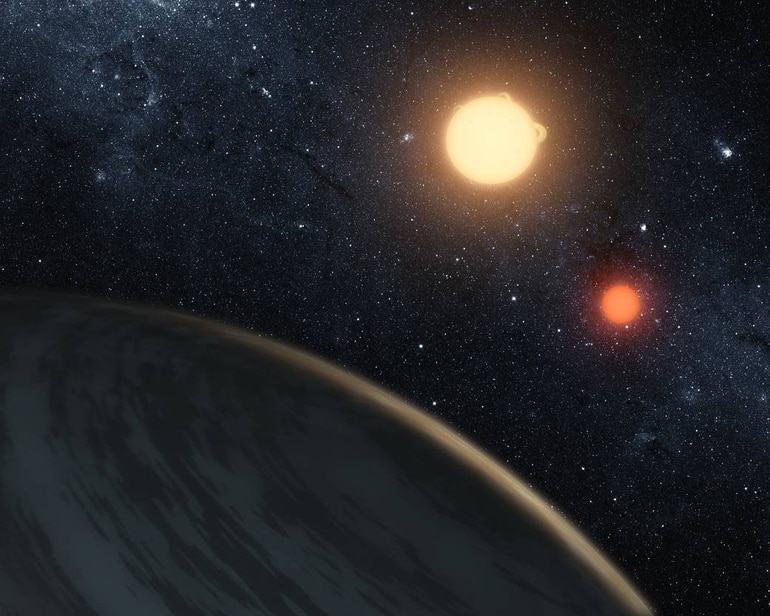Planets orbiting “short-period” binary stars—those locked in a close orbital embrace—can shoot off into space as a consequence of their host’s evolution, a new study suggests.
The findings help explain why astronomers have detected few circumbinary planets—which orbit stars that in turn orbit each other—despite observing thousands of short-term binary stars, or ones with orbital periods of 10 days or less.
It also means that such binary star systems are a poor place to aim future ground- and space-based telescopes to look for habitable planets and life beyond Earth.
There are several different types of binary stars, including visual and spectroscopic binaries, named for the ways astronomers are able to observe them.

Tidal forces
In a new paper accepted for publication in the Astrophysical Journal, lead author David Fleming, an astronomy doctoral student at the University of Washington, reports studying eclipsing binaries, or those where the orbital plane is so near the line of sight that both stars are seen to cross in front of each other.
“There’s a region that you just can’t cross—if you go in there, you get ejected from the system.”
When these binaries orbit each other closely, within about 10 days or less, Fleming and coauthors wondered, do tides—the gravitational forces each exerts on the other—have “dynamical consequences” to the star system?
“That’s actually what we found” using computer simulations, Fleming says. “Tidal forces transport angular momentum from the stellar rotations to the orbits. They slow down the stellar rotations, expanding the orbital period.”
This transfer of angular momentum causes the orbits not only to enlarge but also to circularize, morphing from being eccentric, or football-shaped, to perfect circles. And over very long time scales, the spins of the two stars also become synchronized, as the moon is with the Earth, with each forever showing the same face to the other.
Unstable orbits
The expanding stellar orbit “engulfs planets that were originally safe, and then they are no longer safe—and they get thrown out of the system,” says coauthor Rory Barnes, assistant professor of astronomy.
Further, the ejection of one planet in this way can perturb the orbits of other orbiting worlds in a sort of cascading effect, ultimately sending them out of the system as well.
Making things even more difficult for circumbinary planets is what astronomers call a “region of instability” created by the competing gravitational pulls of the two stars.
“There’s a region that you just can’t cross—if you go in there, you get ejected from the system,” Fleming says. “We’ve confirmed this in simulations, and many others have studied the region as well.”
This is called the “dynamical stability limit.” It moves outward as the stellar orbit increases, enveloping planets and making their orbits unstable, and ultimately tossing them from the system.
Fleming says another intriguing characteristic of these kinds of binary systems, detected by others over the years, is that planets tend to orbit just outside this stability limit, to “pile up” there. But scientists aren’t sure how the planets get to the region—they may form there, or may migrate inward from farther out in the system.
Applying their model to known short-period binary star systems, the researchers discovered that this stellar-tidal evolution of binary stars removes at least one planet in 87 percent of multi-planet circumbinary systems, and that’s likely a conservative estimate. The number may be as high as 99 percent, Barnes says.
Where to look next?
The researchers dubbed the process the Stellar Tidal Evolution Ejection of Planets, or STEEP. Future detections—or non-detections—of circumbinary around short-period binary stars, will provide the best indirect observational test of the process, they say.
The shortest-period binary star system around which a circumbinary planet has been discovered was Kepler 47, with a period of about 7.45 days. Future studies looking to find and study possibly habitable planets around short-term binary stars should focus on those with longer orbital periods than about 7.5 days.
Here’s a new plan for finding life on other planets
As for habitability and the search for life, the researchers say planets orbiting short-term eclipsing binaries might otherwise be attractive targets for closer study, with their edge-on angle showing eclipses, and more, to the distant viewer.
“But this mechanism tends to kill them,” Fleming says. “So, it’s not a good place to look.”
Fleming will present the paper this week at the Division on Dynamical Astronomy conference.
The work used storage and networking infrastructure from the Hyak supercomputer system at the University of Washington. The NASA Astrobiology Institute through the University of Washington-based Virtual Planetary Laboratory funded the work. Funding from the NASA Space Science Fellowship Program supports Fleming.
Source: University of Washington



